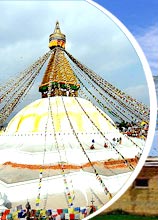
 |
|||||||||||||||||||
    |
|
|
|
Durbar Square Kathmandu
 The
Durbar square is same to Nepal as Tianmen Square is to Beijing. The
place has been listed in the UNESCO world heritage site. Durbar Square
is the focal point of religious and social activities in Kathmandu Old
City. This place comprises palaces, temples, shrines, statues and
courtyards built between the 12th and 18th centuries by the ancient
kings of Nepal. The Durbar square is the subtle amalgamation of old and
new. The elaborately carved architectural features and curving roofs are
night stays for beggars and tourists. Priests and monks who jostle along
the crowd to attract a possible client accompany them. The
Durbar square is same to Nepal as Tianmen Square is to Beijing. The
place has been listed in the UNESCO world heritage site. Durbar Square
is the focal point of religious and social activities in Kathmandu Old
City. This place comprises palaces, temples, shrines, statues and
courtyards built between the 12th and 18th centuries by the ancient
kings of Nepal. The Durbar square is the subtle amalgamation of old and
new. The elaborately carved architectural features and curving roofs are
night stays for beggars and tourists. Priests and monks who jostle along
the crowd to attract a possible client accompany them. Two ferocious looking stone lions guard the gates of Old Royal Palace that was abandoned by the monarchs in the late 18th century. The campus contains a number of courtyards and several museums. There is a plaque that is set in the palace walls which is said to be 400 years old. The inscriptions written on the plaque is in 15 different languages. On the other side of the square is the Kastha Mandap temple that is said to have bore its name to Kathmandu. The unique feature of this temple is that it has been constructed of wood out of a single tree. The structure is an open pavilion that is topped by a pyramidal tower. It is purportedly the Valley's oldest building. Kathmandu Durbar square, also known as Hanuman Dhoka Durbar, used to be the residence of the Nepali royal family and administrators. The palace became a public attraction when the monarchs shifted to the newly build Narayanhity Palace. The Hanuman Dhoka Durbar lies in the heart of the city. It consists of huge Royal Palace with different temples dating from the 15th to the 18th century. This palace is named after Hanuman, a Hindu deity and a stone statue of Hanuman is placed right next to the main entrance. Some other important monuments worth visiting in the vicinity are as follows:
Besides these, other fascinating part of this palace
complex is the towering Nautale Durbar that overlooks the city. It is
famous for its many intricately carved doors, windows, etc.:
|
 Taj Mahal Tour Taj Mahal Tour Rajasthan Tours Rajasthan Tours Kerala Tours Kerala Tours Kashmir Tours Kashmir Tours Tamilnadu Tours Tamilnadu Tours Adventure Tours India Adventure Tours India Beach Tours India Beach Tours India Desert Tours India Desert Tours India Pilgrimage Tours India Pilgrimage Tours India Ayurveda Tours India Ayurveda Tours India Buddhist Tours India Buddhist Tours India Temple
Tours India Temple
Tours India Sculpture Tours India Sculpture Tours India Golden Triangle Tour Golden Triangle Tour India Heritage Tours India Heritage Tours Hill Tours India Hill Tours India Honeymoon Tours India Honeymoon Tours India Kerala Backwaters Tour Kerala Backwaters Tour India Train Tours India Train Tours Trekking Tours India Trekking Tours India India Wildlife Tours India Wildlife Tours Karnataka Tour Karnataka Tour Nepal Tour Nepal Tour Orissa Tour Orissa Tour Gujarat Tour Gujarat Tour Andhra Pradesh Tour Andhra Pradesh Tour Maharashtra Tour Maharashtra Tour Chardham Tour Chardham Tour  Golden Chariot Golden Chariot Himachal Pradesh Tour Himachal Pradesh Tour Sikkim Tour Sikkim Tour Madhya Pradesh Tour Madhya Pradesh Tour
|
||||||||||||||||||||||||||||
| |||||||||||
Copyright © BharatOnline.com | |||||||||||